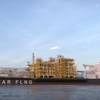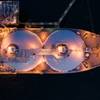TOTE ‘Walks the Walk’
Having sat in this chair for more than two decades, I must admit that I have become somewhat jaded in the sense that there are few developments which actually give me cause to pause. Of course there are the spectacular casualties that will never cease to amaze, but on the business side there are very few real showstoppers.
Then there was last month.
Just as I was literally packing up to head down to New Orleans for the International Workboat Show, news broke that U.S. ship owner TOTE Inc. had sealed the deal to build the world’s first LNG-powered containership (it is a dual fuel MAN main driver, but the full intent is to operate on LNG the majority of the time). As the ships (two firm, three options) are intended for the U.S. to Puerto Rico Jones Act trade, there was no surprise that they must be built in the U.S., in this case at San Diego-based NASSCO. On the surface, to think that a U.S. ship owner and a U.S. shipyard have collaborated to build a ground-breaking, technologically advanced, world-class ship that will not be painted grey is truly amazing. On the surface, that is.
“I’m a little surprised that it came as fast as it came, but I’m not surprised that an American ship owner has decided to invest in this technology,” succinctly summarized Ole Grøne, long-time Senior Vice President Low-Speed Sales and Promotions at MAN Diesel & Turbo.
Ship owners large and small are facing ever stringent rules governing the emissions their vessels put into the sea and into the air. TOTE, which runs six ships in its Puerto Rico and Alaska services, was forced to introduce new containerships, as the ships serving its Puerto Rico trade must be pulled from service in 2019 due to North American ECA regulations.
When I spoke to Anthony Chiarello, President and CEO of TOTE Inc., last month regarding the deal, he essentially said the decision to build these groundbreaking ships with an LNG powered main drive was a no-brainer.
“I don’t know what LNG is going to cost three years from now when the ships come out; but I absolutely know what the impact will be in terms of emissions: that’s not going to change. If there’s an advantage from a fuel cost perspective, that will be wonderful, but that’s not what this decision was based upon: it was purely an environmental consideration,” Chiarello said.
And for followers of the U.S. shipbuilding market, it should equally be of little surprise that NASSCO landed the order. The shipyard has an established relationship with the owner, but more so it has – under the steady guidance of long-time leader and president Fred Harris – been an investor in itself, via relationships with design and procurement partner Daewoo Ship Engineering Company, and directly through investments in its facilities, people and modern management initiatives.
“I think this contract symbolizes two significant points,” said Harris. “First, the United States can still take a leading position in the global maritime industry by smartly teaming and learning from world-class shipbuilders … and second, this contract represents that the Jones Act is alive and well.”
Coverage of the deal and the new ships, with insights from leading executives at each of the main players, starts on page 32.
In the big picture, the TOTE deal is really just a microcosm of the trend that will define shipping to and through 2020. The focus on marine fuels, lubes and emissions is growing daily, and while vessel owners lament (to put it very nicely) additional layers of regulation, it is the reality of the world in which they operate.
Literally, it is almost impossible to turn a page in this publication this month which doesn’t in one way or another address energy and its effects on the shipping industry. The USS Makin Island, which was widely hailed as a technological marvel when it was delivered, is now back from its first deployment, and according to the Navy the fuel-saving numbers courtesy of the ship’s hybrid electric propulsion systems are staggering: 4 million gallons of fuel and more than $15 million saved. Henrik Segercrantz reports starting on page 28.
While the global maritime market has been in a collective economic funk since the global financial crisis and ensuing economic malaise of 2008, many signs indicate the abyss has been reached, and in true cyclical maritime fashion, a collective ramp-up in business across the board can be expected starting today, but really picking up steam and moving fast from mid-2014 forward. While the notion of investing in your fleet to meet environmental regulations seven years down the road may sicken the stomach looking at current financials, you can be sure that the quality, long-term players are starting to invest today in preparation for tomorrow.
(As published in the January 2013 edition of Maritime Reporter - www.marinelink.com)















